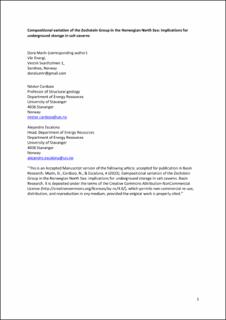| dc.description.abstract | Halite beds in the upper Permian Zechstein Group represent an opportunity for the future development of underground storage caverns. However, geological factors such as lithological heterogeneities, cap rock characteristics and depth can affect the sealing capacity and the integrity of the cavern or contaminate the stored fluid. The main objective of this paper is to evaluate these factors focusing on the compositional variation of the Zechstein Group in different salt structures in the Norwegian North Sea, and related opportunities and challenges for salt cavern storage. Based on deformation style, geometry, height and thickness of the salt structures, we have divided the Zechstein Group into four main categories: (1) thin beds, which can be either carbonate-anhydrite or clastic dominated. Halite is absent and therefore there is no potential for the development of salt caverns. (2 and 3) bedded to weakly deformed evaporites and intermediate size salt structures, where thick halite beds of more than 300 m are present, but they are usually deeper than 2000 m. Lithological heterogeneities in the halite consist of a mix of competent and incompetent (K-Mg salts) lithologies. (4) Tall diapirs, characterized by shallower structures (<2000 m), with large deformation and poor seismic image. Thin layers of incompetent K-Mg salts are observed in these diapirs. The composition, thickness and deformation of the cap rock vary greatly in the area. Thick halite beds are recognized in most salt structures, suggesting an opportunity for underground storage. The challenges are related to the depth of the halite, amount and type of heterogeneities, characteristics of the cap rock and deformation in the different salt structures. These results also have implications for the distribution of reservoir and source rocks, and the evolution of the Northern Permian Basin. | en_US |
